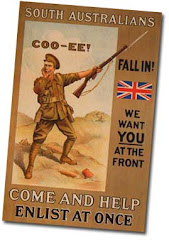
Alan Bigg was born at Nairne, SA on 9 March 1895, the son of Richard and Harriet Louisa (nee Atkinson) who ran a general store in the town. Alan and his brothers attended Nairne Public School until 1905 when the family moved to a farm near Echunga, and they were schooled at the Hahndorf Academy. Alan served in the senior cadets and citizen forces and was apprenticed as an electrical engineer to Newton McLaren in Leigh Street, Adelaide from 1910 until he enlisted. While he was at Newton McLaren he lived in a boarding house in Norwood.
With his father's permission, on 16 June 1915 he enlisted under regimental number 1419 in the 11th reinforcements of the 3rd Light Horse Regiment. He arrived in Egypt in late November 1915, and received training as a signaller using semaphore, heliograph and telephone before joining A Squadron, 3rd Light Horse Regiment. He was kept very busy manning observation posts along the front with the Turks around Girga between February and April 1916. He returned to Zeitoun for more signals instruction in May 1916, then rejoined the regiment in mid June 1916 when they were operating near Romani.
After going on several fighting patrols in the area, he was with A Squadron during the Turkish attack on Mount Meredith in the early stages of the Battle of Romani on 4 August 1916. He was shot through the right foot during the fighting withdrawal of 1st Light Horse Brigade. The regimental doctor couldn't treat him due to the battle conditions, so he propped his foot on his horse's feedbag and rode back to the 2nd Light Horse Field Ambulance where they dressed his foot and evacuated him back to Cairo where two days later his foot was operated on. After examination, a medical board determined that he would be unfit for further service because of his wound. He left Egypt to return to Australia, and after a short stopover in Melbourne, returned to Adelaide on 2 October 1916. He was treated at 7th Australian General Hospital at Keswick Barracks for six months after his discharge in March 1917.
Before the war ended Alan, his brother Lloyd and their parents moved from Echunga to Adey Rd, Blackwood to finish building the house that Alan and Lloyd's brother Lyn had been building before he enlisted. Lyn died of wounds during the War. Alan worked for another engineering firm in 1918, then on ships of the Adelaide Steamship Company until 1922. He married Dorothea Alice Hewett on 20 October 1923 at the Blackwood Methodist Church, and they had two children, Margaret and Robert. He worked as a carpenter on the '1000 homes' project in Colonel Light Gardens in the 1920's, then turned to poultry farming in Ascot Park during the Depression. His wife passed away in 1975, and he remained at Ascot Park until shortly before he passed away in 1984 at the age of 89 and was cremated at Centennial Park. His name is inscribed on the Echunga War Memorial.







